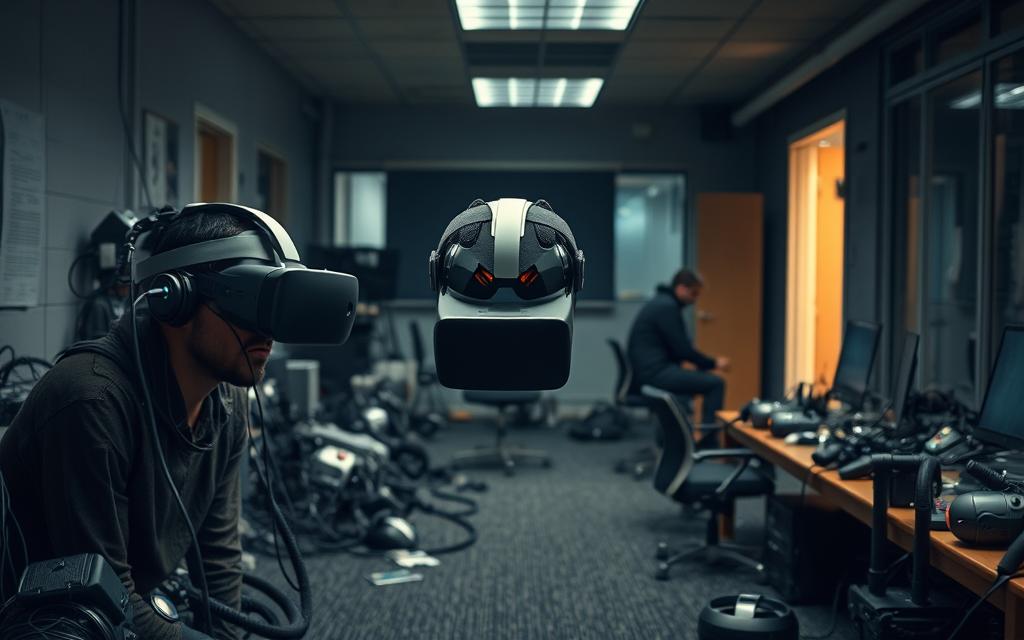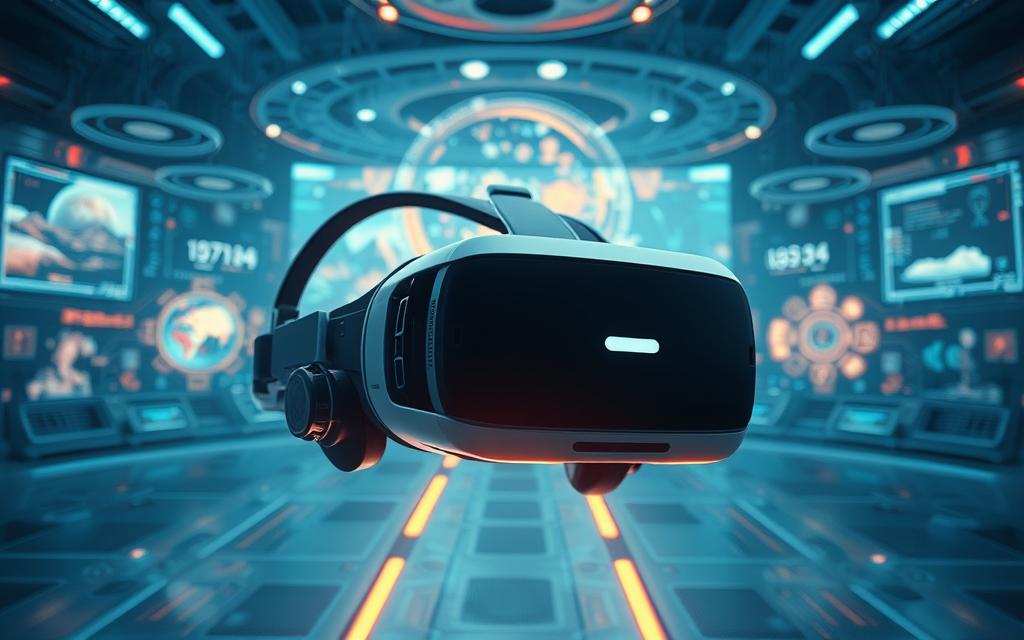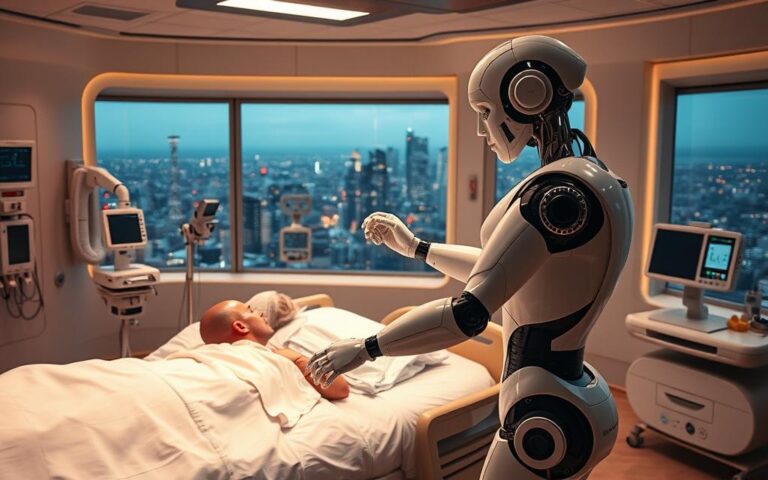The virtual reality market in the United States is expected to reach over $57 billion by 2027. This growth shows a shift from just gaming to various fields. Now, virtual reality technology is changing our way of learning, treating patients, attracting customers, and running businesses.
Through immersive learning in schools to new uses in healthcare, VR is breaking new ground. Let’s dive into how VR transforms everyday life and shapes the future of many sectors.
Understanding Virtual Reality: A Primer
Virtual reality (VR) makes you feel like you’re in another world. You can walk around in digital places that look real or totally imaginary. With VR gear, everything from what you see to what you touch feels real.
What is Virtual Reality?
Virtual reality is all about putting you somewhere else without moving. When you put on a VR headset with sensors, you step inside a 3D space. You can explore or play in this space, and it’s used for fun, learning, healing, and training.
Key Technologies Behind VR
Several technologies make VR possible:
- Headsets: Tools like the Oculus Rift, HTC Vive, and Sony PlayStation VR bring visuals and sounds to life.
- Motion Tracking: With gyroscopes, accelerometers, and sensors, a VR setup watches how you move to react in real time.
- Software: Smart software builds the 3D worlds using game-making tools like Unity or Unreal Engine.
How VR Differs from Augmented Reality
It’s important to know how VR is different from augmented reality (AR). They both change how we see things, but in unique ways:
| Feature | Virtual Reality | Augmented Reality |
|---|---|---|
| Immersion Level | Fully immersive | Partially immersive |
| Environment | Completely synthetic | Real world plus digital elements |
| User Interaction | In a virtual space | In both real and digital spaces |
| Applications | Gaming, simulations, training | Navigation, fixing things, ads |
Knowing these differences helps us see what each technology can do. This is key for talking about how we’ll use them.
The Evolution of Virtual Reality Technology
The journey of VR technology is a thrilling story of growth and innovation. It started in the 1960s, creating the basics for today’s immersive experiences. With new tech, virtual reality software becomes more powerful, blending into different areas smoothly.
Early Developments in VR
The Sensorama was among the first to offer a multisensory experience. It combined sights, sounds, and smells. This was a key step for VR, showing off its potential beyond normal media. Then, the 1980s brought us head-mounted displays, pulling users into virtual spaces.
Milestones in VR History
In the 1990s, VR systems became easier to get. Sega and Sony made big impacts on the gaming world with their VR headsets. These steps proved VR’s worth and set the stage for more breakthroughs.
Modern Innovations Driving VR Growth
Lately, VR development has picked up speed with better graphics, touch feedback, and no wires. These upgrades make VR more real, turning it into a key tool in many fields. From games to learning, VR is changing how we engage with digital worlds.
Applications of VR in Education
Virtual reality makes learning fun and engaging. It offers experiences that help students understand and remember complex ideas better. This method supports different ways of learning, making education accessible and enjoyable for everyone.
Immersive Learning Experiences
VR takes learners on immersive experiences to historical sites or through the human body in 3D. For instance, they can explore ancient worlds or understand anatomy up close. These interactive lessons make learning exciting and help students grasp subjects more deeply.
Enhancing Classroom Engagement
Using VR in class boosts student involvement. It turns usual lessons into dynamic, engaging activities. Teachers can create captivating lessons with VR, making learning more interesting and productive.
Training Simulations for Students
VR offers realistic training for students in areas like medicine and engineering. They can safely practice complex tasks in these virtual settings. This safe, real-world practice helps students learn important skills confidently.
Virtual Reality in Healthcare
Virtual reality is changing healthcare by offering new ways to treat patients, train medics, and help mental health. This tech lets doctors improve how they care for patients and teach medical skills.
Patient Treatment and Therapy
Therapists use virtual reality for exposure therapy. It allows patients to face fears in a controlled setting. This method is great for dealing with anxiety and phobias. By using VR, patients can slowly get used to what scares them, which helps them learn how to cope better.
Medical Training and Education
VR is making medical training better. It lets future healthcare workers practice surgeries and other procedures safely. This risk-free practice improves their learning and skills, which makes for more capable doctors and nurses.
VR for Mental Health Interventions
Virtual reality is also used in mental health care. It’s proving to be effective for treating conditions like PTSD and social anxiety. With VR, patients go through therapeutic activities in special environments, helping them heal and improve. This use of VR is making a big difference in how patients recover.
VR’s Role in Real Estate
VR is changing the game in real estate. It lets potential buyers check out properties from anywhere, at any time. This big change means people can look at homes without worrying about location limits.
Virtual Tours and Property Showings
Virtual tours let buyers see homes from the couch. They can walk through houses, see how rooms connect, and imagine their stuff in the space. Now, agents can show homes all day, every day, reaching more people.
Enhancing Marketing Efforts
VR makes real estate ads much cooler. Instead of just photos and videos, properties get a 3D showcase. It helps buyers see themselves living there and appeals to folks who love new tech. These virtual views make a property more engaging.
Saving Time and Resources
VR makes house hunting faster by letting people visit homes online. This cuts down on the need for real-life viewings. It’s a win-win: buyers find what they want quicker, and agents spend less time showing homes. VR is a smart move for selling property today.
Virtual Reality in Retail
Virtual reality is changing how we shop by offering new virtual experiences. It lets customers see and interact with products in exciting ways. This technology is now a big part of retail, making shopping easier and more fun.
Virtual Shopping Experiences
Virtual reality lets customers visit lifelike stores without leaving home. They can look at items closely and try on clothes virtually. This makes shopping more fun and personal.
Personalized Customer Interactions
VR helps stores create shopping experiences just for you. By using your shopping history, stores can suggest products you might like. For example, seeing how a sofa looks in your room before buying it increases happiness and loyalty.
Impact on Consumer Behavior
VR has changed the way people shop. Shoppers feel more sure about their purchases after exploring products virtually. It makes online and in-store shopping feel the same. This encourages stores to use more technology to meet customer needs.
The Future of VR in Entertainment
Virtual reality is moving beyond just games into all areas of fun. With new VR tech, creators are changing how we enjoy stories. Now, people can dive deeply into tales, not just watch from afar.
Expanding Beyond Gaming
VR is opening up new types of fun, like interactive documentaries and immersive theater. It lets fans feel closer to their favorite singers through virtual concerts. With VR, there’s something for everyone in entertainment.
New Genres and Formats
VR tech is making new ways to tell stories. People can choose how stories go, meet characters, and see places like never before. We’re going to see more genres, all thanks to VR’s power to change how we experience stories.
Collaborations with Filmmakers
Big-time filmmakers are getting into VR to show their stories in new ways. Team-ups across different fields are sparking new ideas. These projects focus on mixing great storytelling with the latest VR tech.
Challenges Facing Virtual Reality Adoption
Virtual reality tech is growing fast, but it faces hurdles. Overcoming these obstacles is key for its success across different areas.
Technical Limitations and Accessibility
VR’s success needs good tech support. Lack of fast internet limits its use in some places. Also, VR gear and powerful computers put it out of reach for some.
This makes VR hard for many to use. Thus, we’re not fully tapping into its benefits yet.
Costs and Investment Obstacles
Starting with VR can cost a lot. The gear and software needed take a big budget. This makes individuals and businesses think twice about using VR.
They have to think about if the cost is worth it. This hesitation slows down VR’s growth and its benefits.
Addressing Consumer Concerns
Users have worries about VR, like data privacy and addiction. These concerns must be tackled by developers. Being clear about how data is used and having tight security is key.
Making VR feel less isolating by adding social features is also important. It could get more people to try VR.

Conclusion: The Potential of VR Beyond Gaming
Virtual reality is growing fast, with uses that reach well beyond just games. Thanks to new tech, VR is entering different areas, changing how we do things, educate, and communicate.
The Ongoing Innovations
VR is becoming easier for everyone to use, thanks to tech improvements. Now, we have better hardware and software, bringing us closer to real-life experiences. This makes VR great for learning in schools, treating patients in hospitals, and showing homes in real estate.
How VR Will Shape Various Industries
VR’s influence is clear in many areas, such as healthcare for therapy and training, and in real estate for viewing properties. It’s changing shopping too, by offering unique experiences to customers, shaping how they buy things.
Embracing the Future of Virtual Experiences
As VR becomes part of our regular lives, it’s changing our interactions with our environment. These changes show a future where learning, healing, and shopping through VR becomes normal. Adopting VR means looking forward to a future filled with creative ways to come together, learn, recover, and shop, transforming our life experiences.




